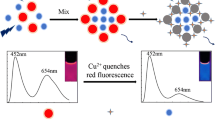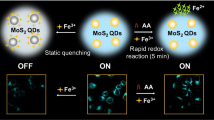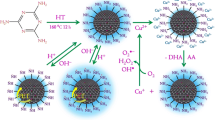Abstract
This work established a fluorescence approach for detecting ascorbic acid (AA) based on Cu-ZnCdS quantum dots (Cu-ZnCdS QDs) and α-MnO2 nanorods. Cu-ZnCdS QDs and α-MnO2 nanorods were characterized by high-resolution transmission electron microscopy (HRTEM), fluorescence spectroscopy, inductively coupled plasma optical emission spectroscopy (ICP-OES) and X-ray diffraction (XRD). In the presence of α-MnO2 nanorods, the fluorescence of Cu-ZnCdS QDs was greatly quenched through the inner filter effect (IFE). Subsequently, AA can trigger the decomposition of the α-MnO2 nanorods which can reduce α-MnO2 to Mn2+ and recover the fluorescence. Under optimal conditions, a linear relation was obtained over the range 5.02−401.77 μM with a 31.62 μM detection limit. Through applying the fluorescent sensing system for detecting AA, a satisfactory result is obtained with recoveries ranging from 89.23% to 110.99%.










Similar content being viewed by others
References
Cobley JN, McHardy H, Morton JP, Nikolaidis MG, Close GL. Influence of vitamin C and vitamin E on redox signaling: Implications for exercise adaptations. Free Radical Bio Med. 2015;84:65–76.
Hu G, Guo Y, Xue Q, Shao S. A highly selective amperometric sensor for ascorbic acid based on mesopore-rich active carbon-modified pyrolytic graphite electrode. Electrochim Acta. 2010;55(8):2799–804.
Childs A, Jacobs C, Kaminski T, Halliwell B, Leeuwenburgh C. Supplementation with vitamin C and N-acetyl-cysteine increases oxidative stress in humans after an acute muscle injury induced by eccentric exercise. Free Radical Bio Med. 2001;31(6):745–53.
Wu T, Guan Y, Ye J. Determination of flavonoids and ascorbic acid in grapefruit peel and juice by capillary electrophoresis with electrochemical detection. Food Chem. 2007;100(4):1573–9.
Zhu Q, Dong D, Zheng X, Song H, Zhao X, Chen H, et al. Chemiluminescence determination of ascorbic acid using graphene oxide@copper-based metal-organic frameworks as a catalyst. RSC Adv. 2016;6(30):25047–55.
Zhou C, Li S, Zhu W, Pang H, Ma H. A sensor of a polyoxometalate and Au–Pd alloy for simultaneously detection of dopamine and ascorbic acid. Electrochim Acta. 2013;113:454–63.
Yu Z, Li H, Lu J, Zhang X, Liu N, Zhang X. Hydrothermal synthesis of Fe2O3/graphene nanocomposite for selective determination of ascorbic acid in the presence of uric acid. Electrochim Acta. 2015;158:264–70.
Valente A, Sanches-Silva A, Albuquerque TG, Costa HS. Development of an orange juice in-house reference material and its application to guarantee the quality of vitamin C determination in fruits, juices and fruit pulps. Food Chem. 2014;154:71–7.
Klimczak I, Gliszczyńska-Świgło A. Comparison of UPLC and HPLC methods for determination of vitamin C. Food Chem. 2015;175:100–5.
Ortega Barrales P, Fernández de Córdova ML, Molina Dı́az A. Indirect determination of ascorbic acid by solid-phase spectrophotometry. Anal Chim Acta. 1998;360(1/3):143–52.
Gazdik Z, Zitka O, Petrlova J, Adam V, Zehnalek J, Horna A, Reznicek V, Beklova M, Kizek R (2008) Determination of vitamin C (ascorbic acid) using high performance liquid chromatography coupled with electrochemical detection. Sensors 8(11)
Liu Z, Wang Q, Mao L, Cai R. Highly sensitive spectrofluorimetric determination of ascorbic acid based on its enhancement effect on a mimetic enzyme-catalyzed reaction. Anal Chim Acta. 2000;413(1/2):167–73.
Kong X, Gong Y, Fan Z. The sensitive turn-on fluorescence detection of ascorbic acid based on iron(III)-modulated nitrogen-doped graphene quantum dots. J Fluoresc. 2016;26(5):1755–62.
Dzagli MM, Canpean V, Iosin M, Mohou MA, Astilean S. Study of the interaction between CdSe/ZnS core-shell quantum dots and bovine serum albumin by spectroscopic techniques. J Photoch Photobio A. 2010;215(1):118–22.
Bruchez M, Moronne M, Gin P, Weiss S, Alivisatos AP. Semiconductor Nanocrystals as Fluorescent Biological Labels. Science. 1998;281(5385):2013.
Stobiecka M, Chalupa A. Modulation of plasmon-enhanced resonance energy transfer to gold nanoparticles by protein survivin channeled-shell gating. J Phys Chem. 2015;B119(41):13227–35.
Stobiecka M. Novel plasmonic field-enhanced nanoassay for trace detection of proteins. Biosens Bioelectron. 2014;55:379–85.
Ma F, Sun M, Zhang K, Wang S. A ratiometric fluorescence sensor for highly selective and sensitive detection of mercuric ion. Sensor Actuat B - Chem. 2015;209:377–83.
Rao H, Ge H, Lu Z, Liu W, Chen Z, Zhang Z, et al. Copper nanoclusters as an on-off-on fluorescent probe for ascorbic acid. Microchim Acta. 2016;183(5):1651–7.
Lim KR, Ahn K-S, Lee W-Y. Detection of concanavalin A based on attenuated fluorescence resonance energy transfer between quantum dots and mannose-stabilized gold nanoparticles. Anal Methods. 2013;5(1):64–7.
Bae W, Choi M-G, Hyeon C, Shin Y-K, Yoon T-Y. Real-time observation of multiple-protein complex formation with single-molecule FRET. J Am Chem Soc. 2013;135(28):10254–7.
Wu P, He Y, Wang H-F, Yan X-P. Conjugation of glucose oxidase onto Mn-Doped ZnS quantum dots for phosphorescent sensing of glucose in biological fluids. Anal Chem. 2010;82(4):1427–33.
Shiosaki S, Nobori T, Mori T, Toita R, Nakamura Y, Kim CW, et al. A protein kinase assay based on FRET between quantum dots and fluorescently-labeled peptides. Chem Commun. 2013;49(49):5592–4.
Dong H, Gao W, Yan F, Ji H, Ju H. Fluorescence resonance energy transfer between quantum dots and graphene oxide for sensing biomolecules. Anal Chem. 2010;82(13):5511–7.
Shamsipur M, Rajabi HR. Pure zinc sulfide quantum dot as highly selective luminescent probe for determination of hazardous cyanide ion. Mat Sci Eng C- Mater. 2014;36:139–45.
Hemmateenejad B, Shamsipur M, Samari F, Rajabi HR. Study of the interaction between human serum albumin and Mn-doped ZnS quantum dots. J Iran Chem Soc. 2015;12(10):1729–38.
Kaur M, Pandey OP, Sharma M, Sharma NN, Gaol FL, Akhtar J. Synthesis and characterization of Mn doped ZnCdS core shell nanostructures QDs using a chemical precipitation route. AIP Conf Proc. 2016;1724(1):020057.
Wu P, Yan X-P. Doped quantum dots for chemo/biosensing and bioimaging. Chem Soc Rev. 2013;42(12):5489–521.
Algar WR, Susumu K, Delehanty JB, Medintz IL. Semiconductor quantum dots in bioanalysis: crossing the Valley of Death. Anal Chem. 2011;83(23):8826–37.
Cheng F, Zhao J, Song W, Li C, Ma H, Chen J, et al. Facile controlled synthesis of MnO2 nanostructures of novel shapes and their application in batteries. Inorg Chem. 2006;45(5):2038–44.
Yang C, Deng W, Liu H, Ge S, Yan M. Turn-on fluorescence sensor for glutathione in aqueous solutions using carbon dots–MnO2 nanocomposites. Sensor Actuat B - Chem. 2015;216:286–92.
Wang C, Zhai W, Wang Y, Yu P, Mao L. MnO2 nanosheets based fluorescent sensing platform with organic dyes as a probe with excellent analytical properties. Analyst. 2015;140(12):4021–9.
Lin S, Cheng H, Ouyang Q, Wei H. Deciphering the quenching mechanism of 2D MnO2 nanosheets towards Au nanocluster fluorescence to design effective glutathione biosensors. Anal Methods. 2016;8(19):3935–40.
Deng R, Xie X, Vendrell M, Chang Y-T, Liu X. Intracellular glutathione detection using MnO2-nanosheet-modified upconversion nanoparticles. J Am Chem Soc. 2011;133(50):20168–71.
Wang H-B, Chen Y, Li Y, Liu Y-M. A sensitive fluorescence sensor for glutathione detection based on MnO2 nanosheets-copper nanoclusters composites. RSC Adv. 2016;6(83):79526–32.
Liu J, Chen Y, Wang W, Feng J, Liang M, Ma S, et al. “Switch-on” fluorescent sensing of ascorbic acid in food samples based on carbon quantum dots–MnO2 probe. J Agr Food Chem. 2016;64(1):371–80.
Xu Y, Chen X, Chai R, Xing C, Li H, Yin X-B. A magnetic/fluorometric bimodal sensor based on a carbon dots-MnO2 platform for glutathione detection. Nanoscale. 2016;8(27):13414–21.
Yan X, Song Y, Zhu C, Song J, Du D, Su X, et al. Graphene quantum dot–MnO2 nanosheet based optical sensing platform: a sensitive fluorescence “turn off–on” nanosensor for glutathione detection and intracellular imaging. ACS Appl Mater Interfaces. 2016;8(34):21990–6.
Wu P, Xu C, Hou X, Xu J-J, Chen H-Y. Dual-emitting quantum dot nanohybrid for imaging of latent fingerprints: simultaneous identification of individuals and traffic light-type visualization of TNT. Chem Sci. 2015;6(8):4445–50.
Hongen W, Zhouguang L, Dong Q, Yujie L, Wei Z. Single-crystal α-MnO 2 nanorods: synthesis and electrochemical properties. Nanotechnology. 2007;18(11):115616.
Srivastava BB, Jana S, Pradhan N. Doping Cu in semiconductor nanocrystals: some old and some new physical insights. J Am Chem Soc. 2011;133(4):1007–15.
Grandhi GK, Tomar R, Viswanatha R. Study of surface and bulk electronic structure of II–VI semiconductor nanocrystals using Cu as a nanosensor. ACS Nano. 2012;6(11):9751–63.
Zhai W, Wang C, Yu P, Wang Y, Mao L. Single-layer MnO2 nanosheets suppressed fluorescence of 7-hydroxycoumarin: mechanistic study and application for sensitive sensing of ascorbic acid in vivo. Anal Chem. 2014;86(24):12206–13.
Niu W-J, Shan D, Zhu R-H, Deng S-Y, Cosnier S, Zhang X-J. Dumbbell-shaped carbon quantum dots/AuNCs nanohybrid as an efficient ratiometric fluorescent probe for sensing cadmium (II) ions and l-ascorbic acid. Carbon. 2016;96:1034–42.
Chen J, Ge J, Zhang L, Li Z, Li J, Sun Y, et al. Reduced graphene oxide nanosheets functionalized with poly(styrene sulfonate) as a peroxidase mimetic in a colorimetric assay for ascorbic acid. Microchim Acta. 2016;183(6):1847–53.
Huang S, Qiu H, Zhu F, Lu S, Xiao Q. Graphene quantum dots as on-off-on fluorescent probes for chromium(VI) and ascorbic acid. Microchim Acta. 2015;182(9):1723–31.
Wang L, Gong C, Shen Y, Ye W, Xu M, Song Y. A novel ratiometric electrochemical biosensor for sensitive detection of ascorbic acid. Sensors Actuat B - Chem. 2017;242:625–31.
Li Y, Lin H, Peng H, Qi R, Luo C. A glassy carbon electrode modified with MoS2 nanosheets and poly(3,4-ethylenedioxythiophene) for simultaneous electrochemical detection of ascorbic acid, dopamine and uric acid. Microchim Acta. 2016;183(9):2517–23.
Xing L, Ma Z. A glassy carbon electrode modified with a nanocomposite consisting of MoS2 and reduced graphene oxide for electrochemical simultaneous determination of ascorbic acid, dopamine, and uric acid. Microchim Acta. 2016;183(1):257–63.
Zhao J, Zhao L, Lan C, Zhao S. Graphene quantum dots as effective probes for label-free fluorescence detection of dopamine. Sensor Actuat B - Chem. 2016;223:246–51.
Liu R, Yang R, Qu C, Mao H, Hu Y, Li J, et al. Synthesis of glycine-functionalized graphene quantum dots as highly sensitive and selective fluorescent sensor of ascorbic acid in human serum. Sensor Actuat B - Chem. 2017;241:644–51.
Rong M, Lin L, Song X, Wang Y, Zhong Y, Yan J, et al. Fluorescence sensing of chromium (VI) and ascorbic acid using graphitic carbon nitride nanosheets as a fluorescent “switch”. Biosens Bioelectron. 2015;68:210–7.
Jahan S, Mansoor F, Kanwal S. Polymers effects on synthesis of AuNPs, and Au/Ag nanoalloys: indirectly generated AuNPs and versatile sensing applications including anti-leukemic agent. Biosens Bioelectron. 2014;53:51–7.
Zhu X, Zhao T, Nie Z, Liu Y, Yao S. Non-redox modulated fluorescence strategy for sensitive and selective ascorbic acid detection with highly photoluminescent nitrogen-doped carbon nanoparticles via solid-state synthesis. Anal Chem. 2015;87(16):8524–30.
Liu J-J, Chen Z-T, Tang D-S, Wang Y-B, Kang L-T, Yao J-N. Graphene quantum dots-based fluorescent probe for turn-on sensing of ascorbic acid. Sensor Actuat B - Chem. 2015;212:214–9.
Acknowledgments
This work was supported by a grant from the Two-Way Support Programs of Sichuan Agricultural University (project no.03570113), the Education Department of Sichuan Provincial, PR China (grant nos.13ZA0255, 16ZA0039).
Author information
Authors and Affiliations
Corresponding author
Ethics declarations
Conflict of interest
The authors declare that they have no conflict of interest.
Additional information
Hanbing Rao and Yao Gao contributed equally to this work.
Rights and permissions
About this article
Cite this article
Rao, H., Gao, Y., Ge, H. et al. An “on-off-on” fluorescent probe for ascorbic acid based on Cu-ZnCdS quantum dots and α-MnO2 nanorods. Anal Bioanal Chem 409, 4517–4528 (2017). https://doi.org/10.1007/s00216-017-0389-4
Received:
Revised:
Accepted:
Published:
Issue Date:
DOI: https://doi.org/10.1007/s00216-017-0389-4




